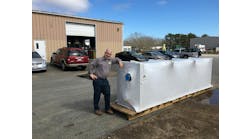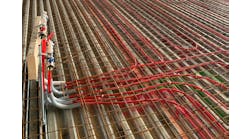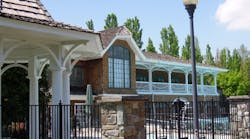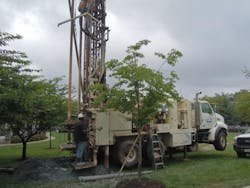GAITHERSBURG, MD. — Harvey Hottel, Inc., a highly diversified mechanical contractor headquartered here has been in business for 70 years. For the past 20, they have been doing geothermal installations.
“It was a pioneer market back then,” Dick Hottel, company CEO said. Hottel is the second of three generations to run the company (and is planning to move to a consultant role within the next few years when his sons take over). He has seen geothermal grow from small, high-end residential jobs to large-scale commercial jobs, while the technology involved has advanced by leaps and bounds.
In the last five years, however, Hottel has really seen the market for geothermal take off in Maryland. “Based on my 50 years in the business,” Hottel said, “this is the greatest market I’ve ever seen… it’s been very good for us.”
Promotions and subsidies from the state of Maryland have been important factors in the rise of the geothermal market. A perfect example is the job Harvey Hottel, Inc., did for the Kentlands Community Center in August-September of 2013.
The center is a 9,000-sq. ft., two-story building with a high glass ratio. The building had a 15-year-old air-source cooling system with a gas furnace heating system that was nearing the end of its service life.
“It’s a high-end community,” Dick Hottel explained, “with all types of houses… and a very active group. They wanted to see if they could do a geothermal application.”
Harvey Hottel, Inc., entered into a design competition for the job. At about the same time the state of Maryland announced its “Game Changer” grant competition. The design team at Harvey Hottel, working with the Mike Heavener of GeoSolar Energy (and a Bosch Thermotechnology rep) decided to submit an application.
“So I made a deal with [Kentlands]: if I get this grant for you, I get to do the job, and they agreed,” Dick Hottel said. “The total project was $277,000, and the grant was for 43 percent — about $120,000 they got in a grant!” The managers of the center say that without the grant they would probably have delayed the job for a year or two.
What made the design a winner with both the state and the Kentlands community was the use of two vertical standing column wells connected in an open loop for the geothermal source. Engineers estimated that a more conventional open-loop system might require as many as 20 wells. And those wells would have been difficult to drill.
“The high level of rock would have made horizontal drilling [for a closed loop system] very difficult,” Hottel said.
Additionally, a standing column system is able to take advantage of heat transfer through conduction, convection and advective heat transfer. The wells were drilled 950-ft. deep into granite and cased to 100-ft. Here the high level of rock actually became an asset. Without it, the casing would have needed to extend all the way down, increasing the cost of the project.
The static water level settled at 14-ft. with a pumping yield of 4 gallons per minute, which was optimal for the final system. “It’s a standing column of water,” Hottel said. “You have a pump down there about halfway, and you’re drawing water from the bottom up, and putting it back in at the top… almost like an open well, but you’re not drawing that high volume of water. It works well.”
The submersible pumps were 2 hp units from Grundfos with variable frequency drive to improve system efficiency. The pumps drew water through a 2” Porter Shroud.
Harvey Hottel, Inc., installed four 6-ton geothermal FHP heat pumps from Bosch Thermotechnology, two single-stage and two two-stage (model numbers ES 070-3 and ES 071-3), to provide better zone control. “We put the [two-stage] units where we had a load that varies,” Dick Hottel said.
Being a retrofit, Hottel had to contend with the old heat distribution system, which meant a lot of work on the old ducts in the attic. “We had to take sections of the ceiling out,” Hottel said. “It was tricky, but we’re used to doing that kind of work.” The building was also in use during the entire retrofit, meaning technicians had to work around the occupants.
The final control set up was a Wi-Fi-enabled, intelligent system that can be monitored and controlled from any browser window. “We can read it remotely from our service center,” Hottel said. “We can even tell the temperature of water coming from the standing column.”
The leaders and facility managers at the Kentlands Community Center have been very satisfied with the performance of their new geothermal system. Even during the extreme “polar vortex” winter of 2013-2014, the supply water to the heat pumps averaged 46°F, providing abundant thermal energy for the heat pumps.
Dick Hottel and his design staff were also pleased that their energy savings estimations came in on the money. “They asked us how much they were going to save in utilities,” Hottel said, “and we estimated 40 percent. Well, after the first year they did their own energy calculations and it came out to exactly 40 percent savings!”
This is not the first standing column geothermal design to prove a success for Harvey Hottel, Inc., and Dick Hottel feels confident it is far from the last. Economical, suitable for the rocky terrain of the mid-Atlantic states, and combining the best traits of open- and closed-loop systems, he sees many more standing column wells in his company’s future.
“In this town, we’ve got a big market. Also in Northern Virginia, D.C…. I don’t think there’s anyone else doing large commercial projects with standing column,” Hottel said. “I feel we have a real niche market there.”



